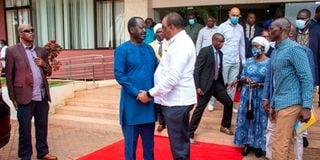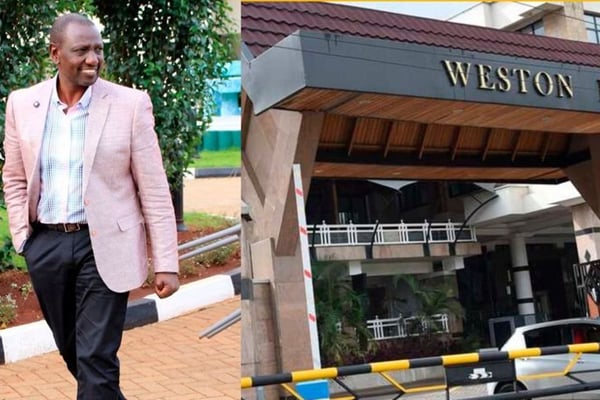How Uhuru Kenyatta ditched buddy William Ruto and turned to 'enemy' Raila Odinga

Azimio la Umoja Coalition flag bearer Raila Odinga with President Uhuru Kenyatta during the Akorino 100 years celebration at Kasarani Stadium on June 19, 2022. PHOTO | POOL | NMG
What you need to know:
- So how did it begin? Back in 2012, President Kenyatta and Dr Ruto faced indictment for crimes against humanity and had their day at the International Criminal Court (ICC) in The Hague
Kenya’s President Uhuru Kenyatta has given credence to the adage that there are no permanent enemies or friends in politics if secession politics in the country is anything to go by.
Picture this: When he was elected President of Kenya in March 2013, his political bosom buddy was William Ruto, his deputy. Today, Dr Ruto is perhaps his worst political enemy, going by the way he endorsed former rival Raila Odinga to succeed him, and whipped up political hotheads to rise up against his former political ally turned foe.
So how did it begin? Back in 2012, President Kenyatta and Dr Ruto faced indictment for crimes against humanity and had their day at the International Criminal Court (ICC) in The Hague. Joined by circumstance, they mounted a campaign of brotherhood, promising to lead the country to reconciliation: The Kikuyu and Kalenjin communities from which President Kenyatta and Dr Ruto came respectively, had fought bitterly after the disputed presidential election in 2007. At least 1,200 people died and thousands others displaced in post-election chaos.
At the time, Dr Ruto backed Mr Odinga for presidency and Kenyatta backed former President Mwai Kibaki.
Fast forward to 2013 and President Kenyatta and Dr Ruto, now in power, showcased unprecedented “bromance,” wearing similar colours of ties and shirts and sharing a lectern during press conferences.
The ICC would withdraw charges against President Kenyatta and discharge his deputy, but with a window to revisit. Then the 2017 elections came and result of the presidential poll was nullified by the Supreme Court, which cited improper procedure in vote tallying. Mr Odinga, the petitioner, boycotted the repeal election in November of that year. President Kenyatta won the repeat polls, but lost the credibility he needed to unite the deeply divided country. Mr Odinga rallied his supporters to protests and fears abounded that the country could sink into chaos.
Behind the scenes, however, President Kenyatta and Mr Odinga were reaching out to each other, seeking to save the country, according to President Kenyatta. On March 9, 2018, the two shook hands on the steps of the Office of the President on Harambee House in Nairobi.
“When we were crafting the Building Bridges Initiative (BBI), they (Dr Ruto and his allies) were involved. I told Raila that we have already formed a government, but we cannot keep fighting every day, let's sit down and solve our differences. In that meeting we never discussed government positions," said President Kenyatta.
The BBI was the immediate project of the handshake. The two argued the country needed to adjust its laws from winner takes-all politics to win-win. They wanted to bring in more than one vice-president, a specified role in government for a losing presidential contender and adjust more government structures to enable presidential appointments.
The BBI faced stiff opposition, however, as opponents including Dr Ruto argued what Kenya needed was to implement the laws, not introduce new ones. A suit filed by the civil society groups eventually defeated the BBI, after court rounds that went up to the Supreme Court earlier this year.
But since the handshake, both President Kenyatta and Mr Odinga have changed their conduct in public. Mr Odinga, a man defined by his abrasive brand of politics, no longer criticises the government. On the contrary, he has turned out to be the government’s foremost defender on a number of issues.
Dr Adams Oloo, who also served as a member of the BBI taskforce that collected views on constitutional changes, says the two saved a disaster by coalescing. “Raila had sworn in himself as the ‘people’s president’. The country was on the brink… therefore, both Uhuru and Raila acted as statesmen,” said Dr Oloo.
The truce has seen its proponents spearhead a joint project, beyond the BBI, such as the new coalition Azimio La Umoja One Kenya which Mr Odinga is vying on to battle Dr Ruto’s United Democratic Alliance.




